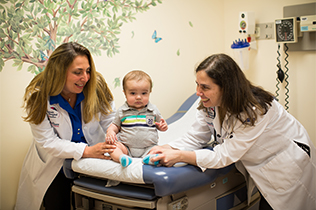Pediatric Liver Transplant
 If we find that your child needs
If we find that your child needs
a liver transplant, you can be confident in the fact that our transplant surgeons and physicians are among the most skilled and experienced in the Northeast. Our success rate is excellent, with a 100% 1-year
and 3-year patient survival rate.
Our program is now part of a special network of the best pediatric transplant centers in the U.S. and Canada called The Studies of Pediatric Liver Transplant (SPLIT). CHAM and other members of SPLIT are committed to using research to improve outcomes for your child and other liver transplant patients.
Our experts may very well opt to treat your child with medications to combat his or her liver disease and its symptoms. This decision often depends on the child’s age and the nature and progression of their illness.
However, we may recommend a transplant if your child has not responded to other treatments and their condition is rapidly deteriorating or has become life threatening.
As your physicians will explain, there are a number of specific reasons why we will opt for transplantation. These include:
- Acute liver failure
- End-stage liver disease
- Portal hypertension with bleeding
- Malnutrition
- Recurring cholangitis
- Unacceptable or diminishing quality of life (poor growth, failure to thrive)
If your child does need a transplant, you can take comfort in the fact that our surgeons and other specialists are among the most experienced and skilled in the Northeast.
Our team is dedicated to providing advanced, compassionate care for your child as he or she prepares for, undergoes and recovers from transplantation. We will take every precaution necessary to keep your child as healthy, strong and complication-free as possible, so that he or she can recover fully and go on to live an active and productive life after surgery.
Our pediatric liver transplant outcomes are excellent, with a 100% 1-year and 3-year patient survival rate.
There are several ways that your child may receive his or her new organ:
- From a deceased donor, who has given permission for their organs to be donated. You will often hear this referred to as a cadaveric procedure.
- From a living donor, who gives your child a part of their liver. Sometimes a portion of a new liver is all that a child will need. The liver is the only organ that can quickly grow back on its own and function properly. Because of this, our surgeons can remove a portion of the donor’s liver, which will then immediately be given to your child. We will conduct tests to see whether or not you or other family members are candidates to be a donor.
We appreciate that transplantation is a family affair and that knowing what to expect will greatly ease your worries and fears. With that in mind, our team will make sure that you understand all aspects of the transplantation process—from organ donation to recovery post surgery and, ultimately, life-long follow-up care.
Please be assured that we will be available 24/7 to address any questions and concerns that you may have. Remember, when you are at CHAM, you are not alone.
We invite you to learn more about the Pediatric Fatty Liver Disease Clinic.